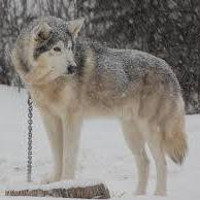Appearance of the Kugsha Dog
|
| Kugshas are undeniably wolf-like in head, size, shape, coat and color. They are large dogs, measuring between 51 and 69 centimeters in height at the withers and sometimes weighing over 45 kilos. Their heads are relatively large, but proportionate to the size of their bodies, with a broad, moderately rounded skull and a slightly tapering muzzle that is almost the length of the skull itself, separated by a moderate stop. Their eyes are almond-shaped and slightly oblique, adding to their wolf-like appearance, as are their pair of fuzzy, erect, triangular ears. Their neck is of medium length, muscular and carries an extra length of hair, which then descends upwards. Their front legs are straight and incredibly robust, built with thick bones and separated by a deep, well-developed chest. Their shoulders are also well developed, but are often masked by excess neck fur. The hind legs are well angulated and muscular, especially at the thigh. Their tails are long and bushy, usually carried downwards. Their coats are double, long and dense, in shades of brown, black, gray, fawn and white, combining to create a wolf-like look. |
Temperament of the Kugsha Dog
|
| Although Kugshas are known to be an exceptionally tough and hard-working breed, they are surprisingly sensitive and require not only a significant amount of exercise, but also special attention, and are prone to developing separation anxiety if left alone for too long. If they are and the problem isn't solved, they tend to become destructive from boredom or frustration, no matter how well trained they are, which is a problem in itself. They are highly intelligent and can therefore be quite stubborn if not trained early by an experienced trainer, capable of being patient, firm and consistent. Socialization is also extremely important because, although they generally get on well with other dogs, they don't always do well with small children because of their prey drive, unless they are raised with them from an early age. However, they make excellent watch and guard dogs, as they are wary of strangers and will assert themselves if they sense a threat is present, alerting their owners with a convincing bark if need be. But all this doesn't mean they can't be good pets either, even if they haven't really come into their own in this capacity. Well-trained and socialized from the start, they're eager to please, loyal and affectionate with their families, and a decent choice for older, more active families. Because of their high energy requirements, they are not suitable for apartment living or inactive families. Because of their heavy double layers, they also don't do well in hot, humid climates. |
Needs and activities of the Kugsha Dog
|
| Kugshas are considered a high-energy breed, and for good reason. Bred and trained to work most of their early years, this breed has excellent stamina and muscle mass which, along with their driving nature, require a considerable amount of daily exercise to keep them happy and healthy. They appreciate having plenty of open space to run around, and generally do much better with families that have large homes, large yards and plenty of room to roam and explore. Because of their potential aggression problems, socialization is of paramount importance if you want to frequent dog parks, and even on walks, you need to watch out if a stranger doesn't know how to handle dogs instead of petting them. They will, however, be good runners - joggers - walkers on a leash, if they are well trained, which will tire them out. Their high intelligence also demands at least some attention. So any game or trick that stimulates them mentally will also wear them out. |
Maintenance of the Kugsha Dog
|
| Kugshas are low-maintenance dogs, even though they're only light in weight. Unless it's high season, they still use a fair amount of shedding to keep their coats clean and free of dirt and lint. A stiff bristle brush or waxer should do the trick several times a week, although serious detangling can also be done if problems arise. They don't need to be bathed frequently, unless they're rolling in scent or have an exceptional odor, but they generally only need a bath every few months, otherwise their coat will be well-groomed. Otherwise, simply check and trim their nails regularly to avoid painful splits and breaks. Because of their high food intake, their teeth need to be brushed at least once a week to help them maintain good oral health. |







 English (United Kingdom)
English (United Kingdom)